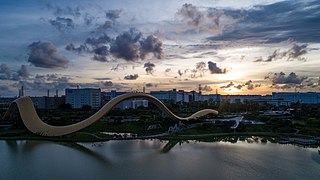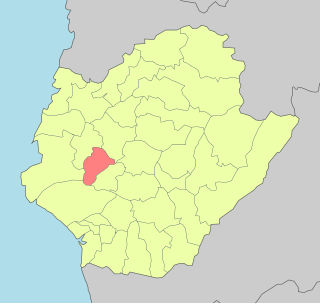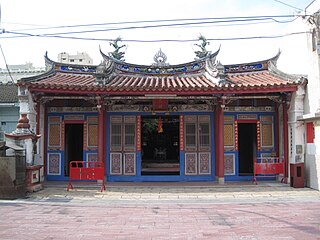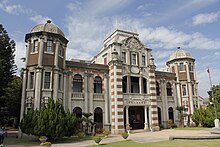
Changhua County is the smallest county on the main island of Taiwan by area, and the fourth smallest in the country. With a total population of 1.24 million, Changhua County is the most populous county in the Republic of China. Its capital is Changhua City and it is part of the Taichung–Changhua metropolitan area.

Yunlin County is a county in western Taiwan. Yunlin County borders the Taiwan Strait to the west, Nantou County to the east, Changhua County to the north at the Zhuoshui River, and Chiayi County to the south at the Beigang River. Yunlin is part of the Chianan Plain, a flat land known for its agriculture. Agricultural products of Yunlin County include pomelo, tea leaves, suan cai, papaya and muskmelon. Yunlin's rivers give it potential for hydroelectricity. Douliu is the largest and capital city of Yunlin. It is the only county on the main island of Taiwan where no city with the same name exists. Yunlin is one of the least developed counties on the West coast, and suffers from emigration.
Lugang or Lukang may refer to:

Sinshih District, alternatively spelled Xinshi, is a rural district in central Tainan, Taiwan, about 11 km north of Fort Provintia. As Sincan, it was one of the most important stations of the Dutch East India Company (VOC) in the 17th century. Missionary work formally began and the largest amount of inland trade occurred at Sinkan.

The Japanese invasion of Taiwan was a conflict between the Empire of Japan and the armed forces of the short-lived Republic of Formosa following the Qing dynasty's cession of Taiwan to Japan in April 1895 at the end of the First Sino-Japanese War. The Japanese sought to take control of their new possession, while the Republican forces fought to resist Japanese occupation. The Japanese landed near Keelung on the northern coast of Taiwan on 29 May 1895, and in a five-month campaign swept southwards to Tainan. Although their advance was slowed by guerrilla activity, the Japanese defeated the Formosan forces whenever they attempted to make a stand. The Japanese victory at Baguashan on 27 August, the largest battle ever fought on Taiwanese soil, doomed the Formosan resistance to an early defeat. The fall of Tainan on 21 October ended organised resistance to Japanese occupation, and inaugurated five decades of Japanese rule in Taiwan.

Sigang District, alternatively spelled Xigang, is a rural district of about 24,611 residents in Tainan, Taiwan. It is home to two elementary schools, one junior high school, and one high school.

Tamsui District is a seaside district in New Taipei, Taiwan. It is named after the Tamsui River; the name means "fresh water". The town is popular as a site for viewing the sun setting into the Taiwan Strait. Though modest in size, it has a large role in Taiwanese culture.

The Lukang Folk Arts Museum is a museum in Lukang Township, Changhua County, Taiwan.

Zhi Hu Zhe Ye is the 1982 debut album of Taiwanese singer Lo Ta-yu.

The Lukang Culture Center or Lukang Assembly Hall is a cultural center in Lukang Township, Changhua County, Taiwan.

The Lukang Ai Gate is an old gate in Lukang Township, Changhua County, Taiwan.

The Lukang Wen Wu Temple is a Wen Wu temple in Lukang Township, Changhua County, Taiwan.

The Lukang Kinmen Hall is a historical hall in Lukang Township, Changhua County, Taiwan.

The Lukang Longshan Temple is a Guanyin temple in Lukang Township, Changhua County, Taiwan.

The Lukang Rimao Hang is a historic building in Lukang Township, Changhua County, Taiwan.

The Lukang Tianhou Temple, also known as the Lukang Mazu Temple, is a Chinese temple dedicated to the Chinese Goddess Mazu, the Goddess of Sea and Patron Deity of fishermen, sailors and any occupations related to sea/ocean. The temple is located at 430 Zhongshan Road in Lukang Township, Changhua County, Taiwan. It is one of the island's most famous and popular Mazu temples.
The architecture of Taiwan can be traced back to stilt housing of the aborigines in prehistoric times; to the building of fortresses and churches in the north and south used to colonize and convert the inhabitants during the Dutch and Spanish period; the Tungning period when Taiwan was a base of anti-Qing sentiment and Minnan-style architecture was introduced; in Qing dynasty period, a mix of Chinese and Western architecture appeared and artillery battery flourished during Qing's Self-Strengthening Movement; During the Japanese rule of Taiwan, the Minnan, Japanese and Western culture were main influencers in architectural designs and saw the introduction and use of reinforced concrete. Due to excessive Westernization as a colony, after the retrocession of Taiwan to the Republic of China in 1945 from Japan at the end of World War II, Chinese classical style became popular and entered into international mainstream as a postmodern design style. Today, Taiwanese architecture has undergone much diversification, every style of architecture can be seen.

The Lukang Artist Village is an art center in Lukang Township, Changhua County, Taiwan.


























